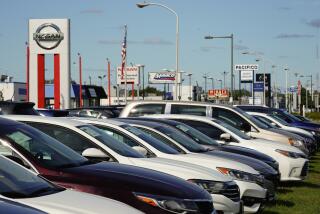Bearish Sentiment Grips Markets; Dow Skids 57.61 : Bank Increases Prime Rate 2nd Time in 8 Days
- Share via
NEW YORK — In a move reminiscent of the rapid-fire prime lending rate increases of the late 1970s, Chemical Bank raised its benchmark lending rate Thursday for the second time in eight days.
The move to 9.75% from 9.25% marked the third prime rate increase in five weeks and the sixth this year. It brought Chemical’s benchmark rate--by which banks set consumer and corporate loan rates--to its highest level since the summer of 1985.
A higher prime rate almost certainly means higher borrowing costs for business and consumers since automobile, credit card and home equity loans are tied to the prime.
Although Chemical’s move was not immediately followed by other major banks, Wall Street is braced for others to join in soon.
Conjecture also spread Thursday on Wall Street that the Federal Reserve Board will boost its discount rate soon--perhaps as early as today and that other major banks would then quickly follow Chemical’s lead by raising their prime rates. The rumor persisted despite Reagan Administration efforts to calm the markets by declaring that market rates will turn down soon and despite a signal from the Fed itself that it will not raise the level at which it lends to commercial banks.
Difficult Decision
“Until the Fed acts, it makes the pricing game very difficult for banks,” said Allen Sinai, chief economist for the investment firm of Shearson Lehman Bros., who noted that the difference between the prime rate and major banks’ own borrowing costs is about what it was before the last round of hikes lifted the prime from 8.75% to 9.25% on Oct. 7.
“Chemical’s very quick move,” he added, “is a tough decision for banks to make because the prime is a hot political potato.”
The Federal Reserve last shifted its discount rate on Sept. 4 when it raised the level at which it lends to commercial banks to 6% from 5.5%. Speculation has been gaining that the renewed weakness of the dollar on world markets will force the Fed to raise its discount rate again--an action that Sinai said could come any time in the next two or three weeks.
After a quick slump immediately following Chemical’s announcement on the prime rate, stocks and bonds appeared to shrug off the news. But in the last half hour of trading, stocks took a drubbing, in part because of wariness over the upward march of interest rates, and the Dow Jones industrial index closed down 57.61 points.
Economists pronounced the prime rate increase predictable in view of big increases in banks’ borrowing costs over the past week alone. Yields on long-term Treasury bonds, for example, surpassed the 10% level this week for the first time in nearly two years--rising from 9.92% last Friday to 10.24% just after Chemical Bank initiated the latest round of increases Thursday afternoon.
High Loan Demand Cited
“The whole run-up in interest rates has been quite rapid, a function of psychology, so this increase was not a surprise,” said Irwin L. Kellner, chief economist at Manufacturers Hanover Trust. Reminded of his prediction last week that the prime would surge to 10% by Christmas, Kellner said, “Christmas could be only a couple of weeks away.”
Driving interest rates up, economists widely agree, are an unseasonably high loan demand and the twin deficits--trade and budget.
“This is certainly a poor sign for business,” said Delos Smith, an economist at the Conference Board, a New York-based business research group. “We just are not seeing the progress we wanted to on either front, so interest rates are going nuts.”
The Commerce Department reported this week that the nation’s trade deficit did fall in August but by only half as much as expected, an announcement that triggered a record 95.46-point drop in the Dow Jones industrial index on Wednesday. And many economists now think that the federal budget deficit this year will be higher than predicted.
More to Read
Inside the business of entertainment
The Wide Shot brings you news, analysis and insights on everything from streaming wars to production — and what it all means for the future.
You may occasionally receive promotional content from the Los Angeles Times.










